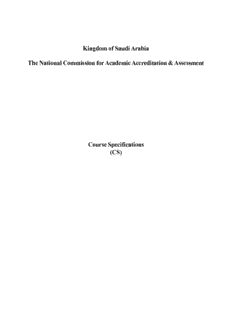
Lanthanides and actinides PDF
Preview Lanthanides and actinides
Kingdom of Saudi Arabia The National Commission for Academic Accreditation & Assessment Course Specifications (CS) Course Specifications Institution: University of Dammam Date: 7/3/2014 College/Department: College of Science for Girls/ Chemistry department A. Course Identification and General Information 1. Course title and code: Lanthanides and actinides CHEM435N 2. Credit hours: Tow credit hours 3. Program(s) in which the course is offered. (If general elective available in many programs indicate this rather than list programs) Chemistry, second term of fourth Year 4. Name of faculty member responsible for the course 5. Level/year at which this course is offered: level 2/ fourth year 6. Pre-requisites for this course (if any) CHEM333N 7. Co-requisites for this course (if any) Does not exist 8. Location if not on main campus College of Science for Girls/ Dammam 9. Mode of Instruction (mark all that apply) a. traditional classroom * What percentage? 90% b. blended (traditional and online) What p e r c e n t a g e ? c . e - l e a r n i n g W h a t p e r c e n t a g e ? d . c o r r e s p o n d e n c e What percentage? f. other What percentage? * 10% B Objectives 1. What is the main purpose for this course? Upon finishing this course the student can successfully: • Recognize the characteristics of the 4f, 5f elements. • Distinguish between characteristics of the 4f, 5f elements and 3d elements. • Understand the different types of radioactive derogations and the extent of its ionization and penetration ability. • Recognize how to treat and prevent dangerous radioactive elements. • Recognize the peaceful uses of radioactive isotopes, especially in the medical field and farm. • Recognize how to make chemical reactions of these elements and their compounds. • Recognize the electronic and magnetic qualities of these compounds and their colors ... 2. Briefly describe any plans for developing and improving the course that are being implemented. (e.g. increased use of IT or web based reference material, changes in content as a result of new research in the field) - Lecturing and simplify the information with the use of information technology and the Internet, or references to the new changes of modern research in the field of study. - The use of visual display PowerPoint. - Linking the lecture content with the presentation of new researches published recently. - The debate and the exchange of roles with the comment on the mutual debate between professor and the students. - Access to modern research and studies related to the topics of decision and take advantage of them. - Some duties assigned to the students and then discussed together. C. Course Description (Note: General description in the form used in Bulletin or handbook) Course Description: 1. Topics to be Covered No. Cont List of Topics of act Week • Introduction to Chemistry of lanthanides elements • Their positions in the periodic table of the elements • Naming of lanthanides elements • The discovery of lanthanides elements 1 2 • Abundance in nature • Extraction methods of crudes • Electronic structure • The most important uses • History of the lanthanides • Properties of lanthanides • Oxidation states of lanthanides 1 2 • Contraction of the radius of lanthanides cations +III • Results of contraction of radius of lanthanides cations +III on the physical and chemical properties • Magnetic properties • Different types of magnetic (paramagnetic – diamagnetic and ferromagnetic) 1 2 • Measurement of the magnetic moment • Electrons 4f movement and their impact on the magnetic properties 3+ •• SMpaegcntreatli cp rmoopmeretinets ooff tlhaen tihoanns iLdens • Absorption spectra and properties of lanthanides 3+ 1 2 • Absorption spectra of the Ln ions • Distinguish between the 4f and 3d spectra • Lanthanide complexes • Introduction to the Chemistry of actinide elements • Position of actinide elements in the periodic table 2 4 • Labels and discovery of actinide elements • Abundance in nature • Electronic structure • Preparation methods of the actinide elements • Properties of actinides • Oxidation states • Contraction of the actinide elements • Most important uses • Physical and chemical properties • Actinide compounds (oxides - metal oxides mixed - halides) 1 2 • Magnetic properties and spectroscopic • Complexes of actinide elements • Oxidation state +III, +IV, +V, +VI and +VII 1 2 • Metal-organic compounds • Introduction to Nuclear Chemistry • Isotopes • Split isotopes according to the degree persistence • Half-life 1 2 • Derogations types of radiation and their ability to ionization and penetration • Shifts resulting from radiation property • Calculation of the nuclear energy binding • Nuclear fission • Definition of nuclear fission • Nuclear chain reaction • Fissile bomb 2 4 • The peaceful applications of fissile reactions (fission reactors) • Reactors (fuel - uranium fuel - tranquilizers - Coolers - poles control - fuel cycle) • The risks and benefits of nuclear reactors • Natural radioactive decay chains • Detection methods for radiation 1 2 • Calculate the average atomic mass • Uses of radioisotopes in medicine and agriculture • Nuclear fusion • Fusion reactions • The dangers of nuclear materials and Prevention (CDC) 1 2 • The most important conditions and precautions to be taken in the prevention of radioactive materials. 2. Course components (total contact hours and credits per semester): Laborator Lecture Tutorial Practical Other: Total y Contact or 30 0 0 0 0 30 Hours Credit 2 0 0 0 0 2 3. Additional private study/learning hours expected for students per week. 1 hour per week 4. Course Learning Outcomes in NQF Domains of Learning and Alignment with Assessment Methods and Teaching Strategy
Description: